You may not find this terribly rewarding unless you're included here, so this is a good time for casual and random browsers to turn back before they get too caught up in the sweep and majesty of the proceedings and can't let go.
We're not based in Europe anymore, and we've struggled through the covid-19 lockdowns like everyone else, so we haven't set foot in Italy since February 2019. Now we're making up for lost time with mad sightseeing, but missing the cats even more sorely as the days fly by.
Ascoli Piceno's neighbors: Offida and Acquaviva Picena
We hired a car at the Fiumicino airport near Rome, and they 'upgraded' us to a Mitsubish SUV battle-tank -- utterly useless in the circumstances. Luckily, Oscar and Cathy have miraculously appeared with an extraordinarily suitable little VW Golf sedan, and we're hitting the highway to take in some of the local villages.
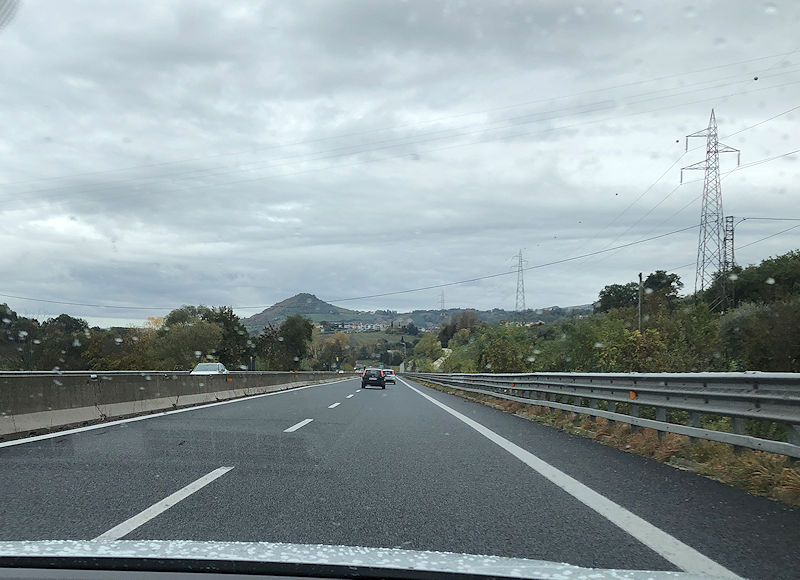
'Highways' was aspirational (as US diplomats add to any int'l agreements with deadlines). As it turned out, this six mile stretch was the only highway we came upon all day. Most of the rest of our itinerary was at least paved.
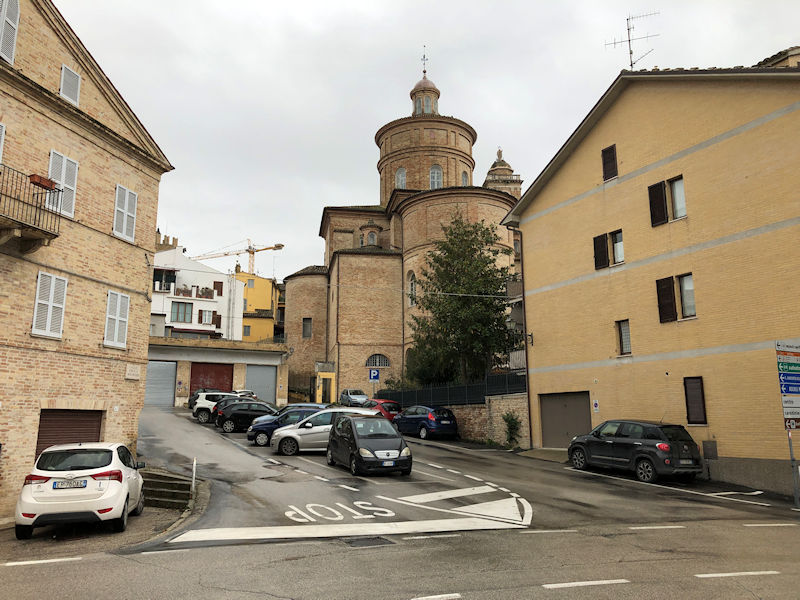
Central Offida. We're parked in a sort of bay in the western side of the hilltop Centro Storico of the town and we're headed up past that church in the centre. Rain is threatening.

This is the southern end of the Piazza del Popolo, staring at the Palazzo Comunale at the far end. The rain has begun.
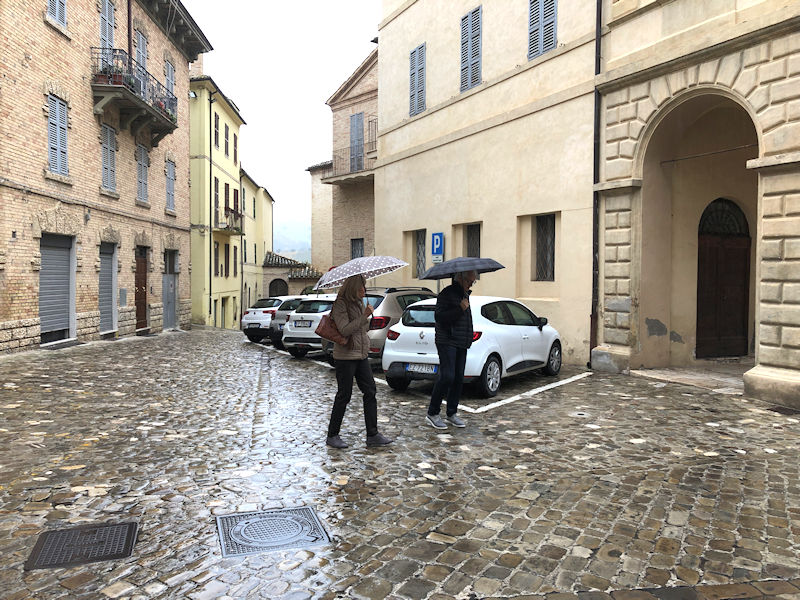
At least some members of our party have had the forethought to bring their brollies.
Offida is presently a small hilltop town with a 2022 population of about 4,700 'Offidani' in the centre and a suburb extending down the hillside to the east and south. It's built on a rocky ridge between the valleys of the Tronto and Tesino rivers, about 7 miles (12km) northeast of Ascoli Piceno.
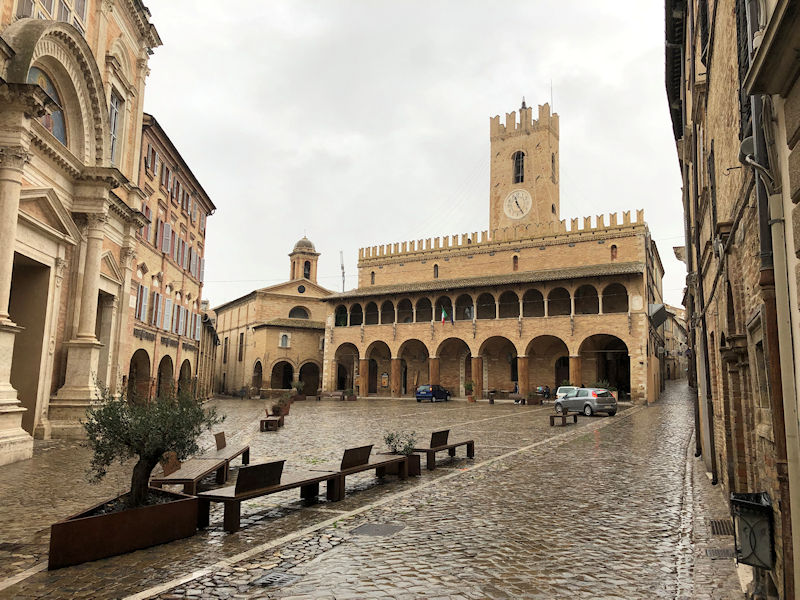
The central square and town hall, with the Chiesa dell'Addolorata (Church of the Sorrows) tucked in behind on the left
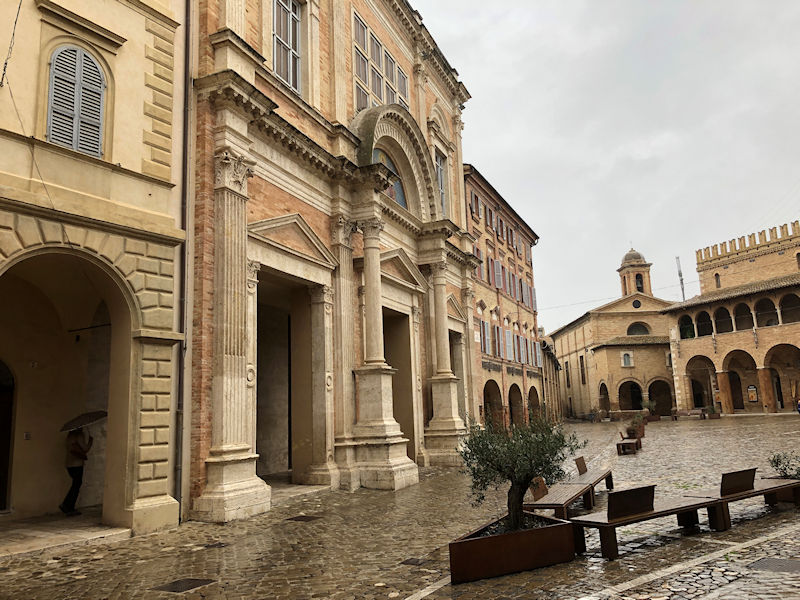
The interesting façade of the Collegiate Church of Santa Maria Assunta, the hind end of which we passed on the way up from the carpark
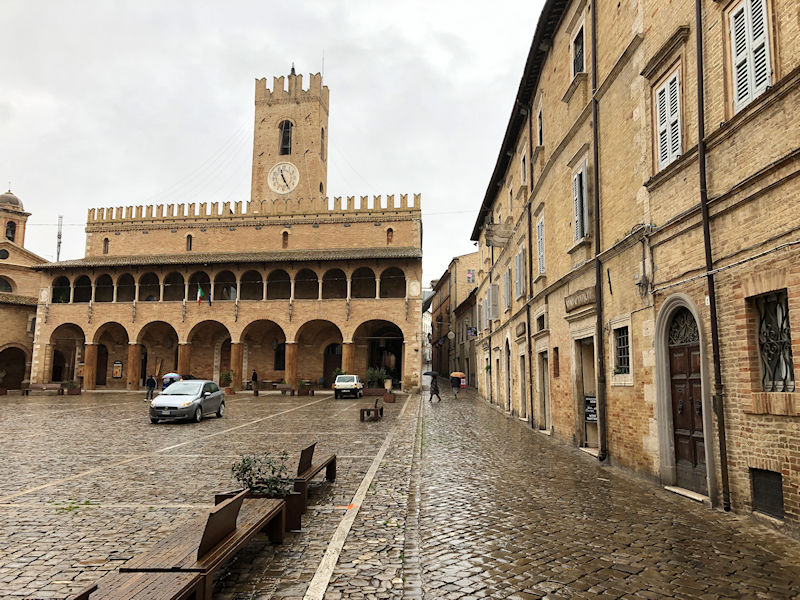
To the right of the town hall is the Corso Serpente Aureo leading down to the surviving medieval fortifications. The area round Offida has revealed evidences of the Piceni tribes from the 7th to 5th centuries BC, as well as remains of the Romans in the region, but the first solid evidence of occupation here is said to date from AD 578 when refugees from the Lombard invasions built several castles on the rocky hilltops roundabout, including on this site.
In a documentary mention from 1039, the castle of 'Ophida' came under the properties of the then-important Benedictine Farfa Abbey. Offida was involved in the 15th century intercommunal wars in the region, and impressive new town fortifications, some of which still survive, were built at that time particularly as protection from the Ascolani in their wars against Fermo.

Here's the Collegiata di Santa Maria Assunta again, at the narrow end of the triangular piazza. It replaces a 13th century Oratorio della Trinita which was demolished in the late 18th century. This one, dedicated to 'Our Lady of the Assumption [into Heaven]', was begun in 1785 on a design by one of the Giosafatti and consecrated by the Bishop of Ascoli Piceno in 1801 (which suggests that the interior might not entirely provide the sort of thing we're looking for).
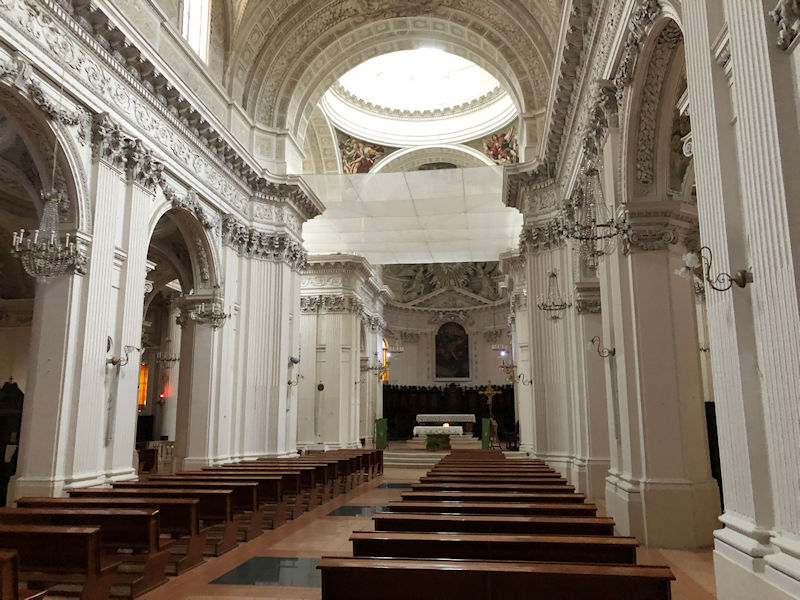
Beloved by the parishioners, no doubt, but need not detain us on this visit.

The little Wine and 'Typical Stuff' shop across the square -- the local wines are one of the two historically significant industries that characterize Offida.

The Palazzo Comunale or town hall dates from the 13th and 14th centuries, including the tower as well apparently, but the portico and arcades and the loggia were added in the 15th century. A tavern and a bar are located on the right side of it, with tables out into the piazza in fine weather, and an important theatre, the Teatro Serpente Aureo, occupies the left side, used for civic cultural events and parties during the Carnival period. There's also an archaeological museum in there somewhere.

Staying out of the rain for the moment
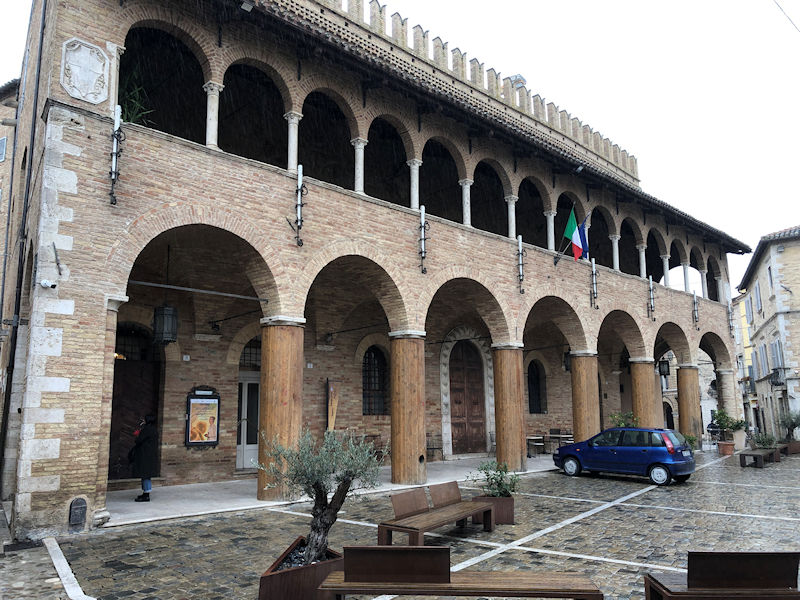
The Palazzo Comunale with the Teatro Serpente Aureo -- the name means 'golden serpent' but its origin here appears to be a well-hidden secret.
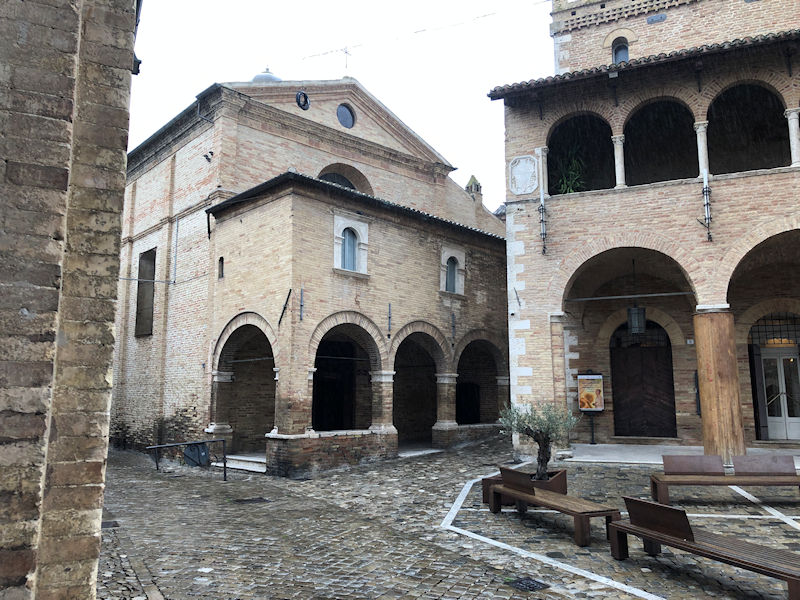
We progress now to the Chiesa dell'Addolorata, dedicated to Our Lady of Sorrows, entered through the portico on the street.
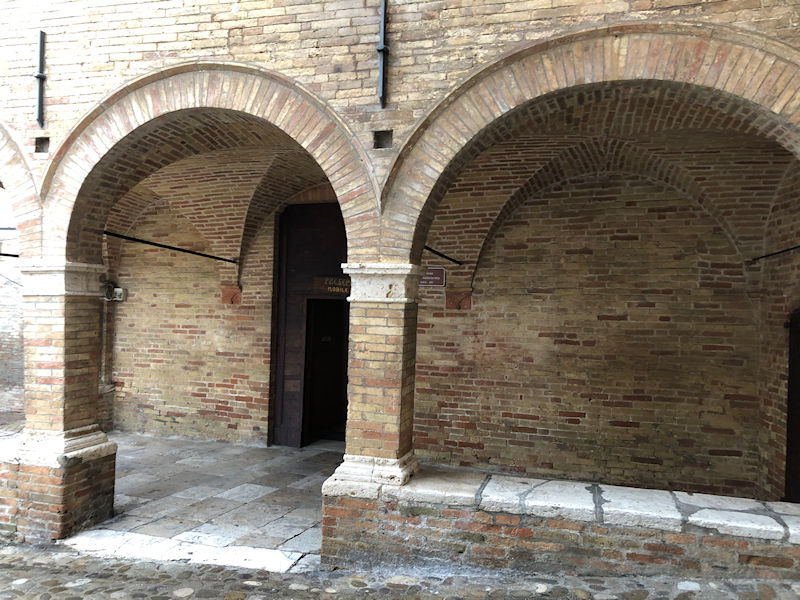
The modest entrance under the portico.

The Christmas Crèche or presepe, a 19th century mobile crèche, in fact

The interior has just a single nave with a gilded wooden altar in the apse . . .
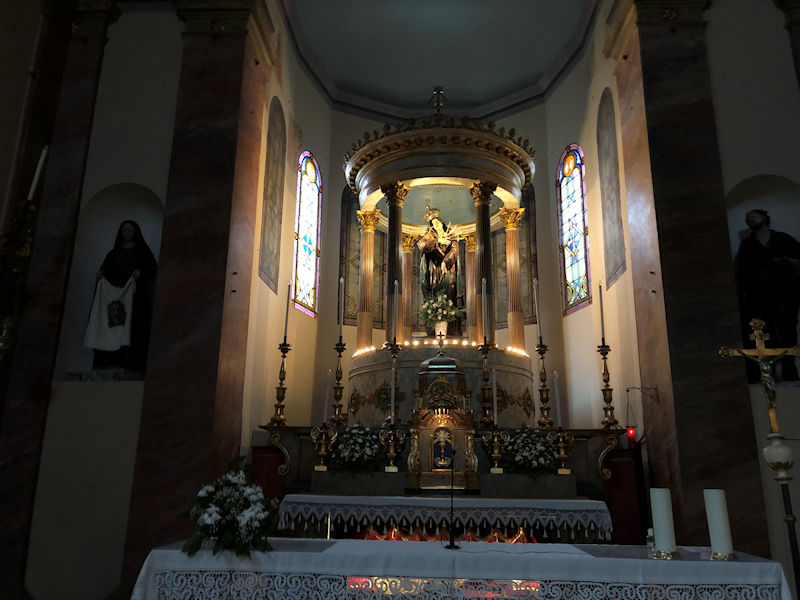
. . . surmounted by a statue of the 'Grieving Madonna' surrounded by saints.

Before the altar is the 'Coffin of the Dead Christ', actually less a coffin than a wagon with a canopy, used to haul the statue of Christ in a 'triumphal procession on the evening of Good Friday', a tradition reaching back to the old medieval guild brotherhoods.

There's one of our favorite saints, Rocco, aka St Roch, a Frenchman who came to northern Italy to help people during the Plague, but contracted the disease himself and went round pointing to a bubo on his thigh to indicate that there was nothing to fear. ['See? I've got one, too, and I'm feeling fine.']

Back in there is the Chiesa del Suffragio -- we didn't get to see it, and possibly couldn't have (a comment on Wikipedia: 'In ruins...too bad!!! The church should be restored: you can't keep a place like this closed!!!!!!!!')

Just down the Via del Merletto is the Piazza Valorani -- that guy's called the 'Statue of the Reaper' (1800). 'Merletto' means lace, and the other traditional industry that the town is noted for is the artisanal manufacture of 'bobbin lace' (lots of little bobbins hanging down with the threads), and this part of town is particularly known for it.
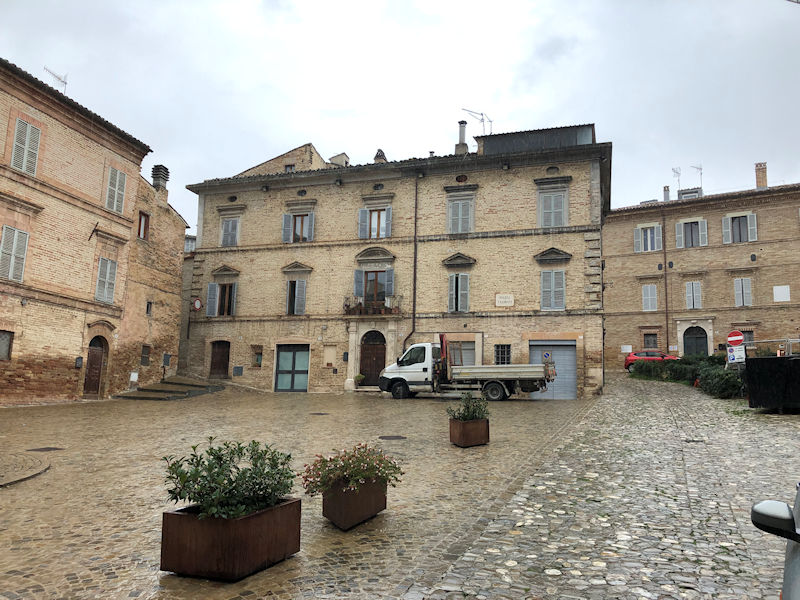
Piazza Valorani, and continuing down the . . .

. . . the Via del Merletto. The special kind of lace here is the Merletto a Tombolo (for which there is a small museum in another part of town a few blocks away).
There are indications of the production of lace here from the 14th and 15th century, and it's mentioned in a document of 1511 for the town's donation of laces to a local church for helping to end a recent plague. Paintings by local artists show angels sporting the laces, and by the early 17th century several local families had taken it up as a trade of their own, increasing the quality and volume of the production. By 1612 it was being exported under contracts with regional merchants.

By the 20th century the lace from Offida was recognized and valued worldwide, we're told, and in 2009 the city received trademark protection under the name 'Merletto a Tombolo di Offida (Offida Pillow Lace)', whereby external lace makers (as I understood it) could apply to be included in the local register here, meet the standards, and use the name. And in 2010 this street, 'The Lace Street', was provided as 'a central narrow street historically devoted to lace making, with the installation of explanatory plates and panels'.
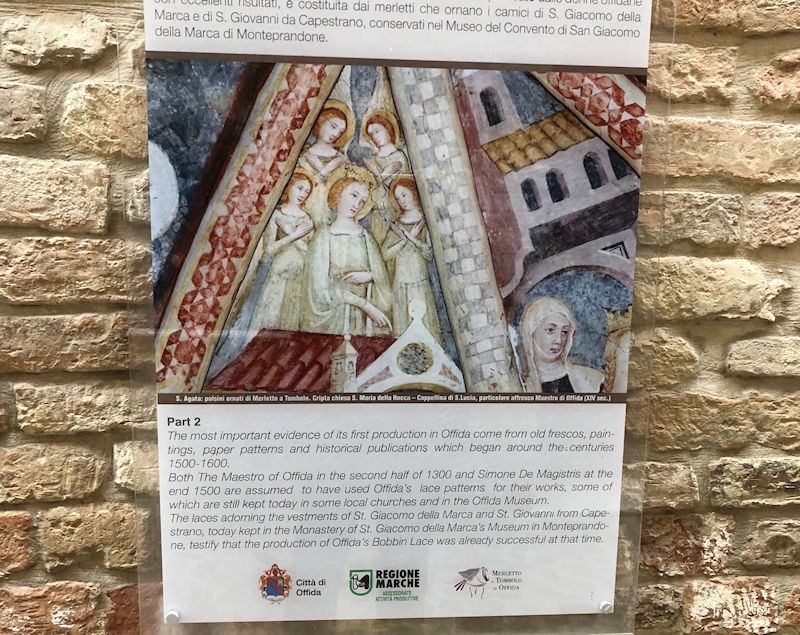
There are five or six such panels progressing down the street, but the texts on them can be found in English here.
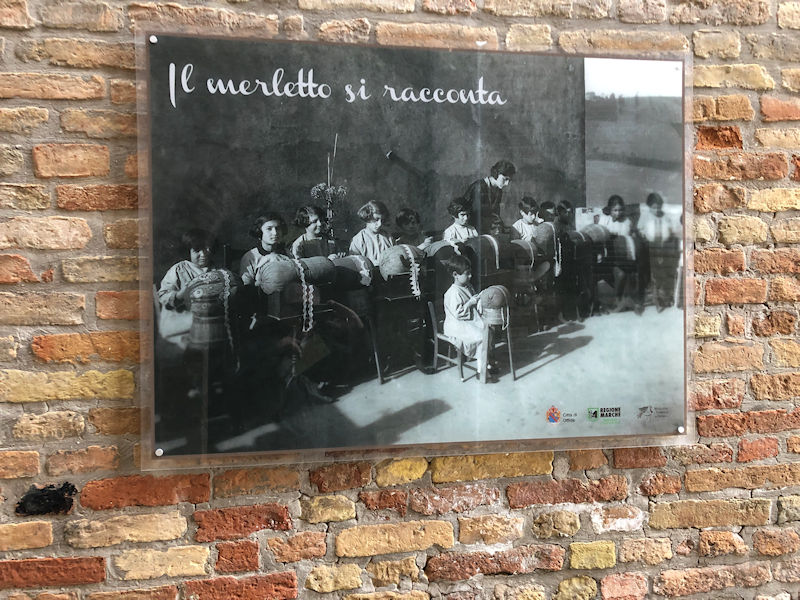
There's a very similar scene represented on the monument to the lace makers at the northern entrance to the city, to which we will soon betake ourselves.
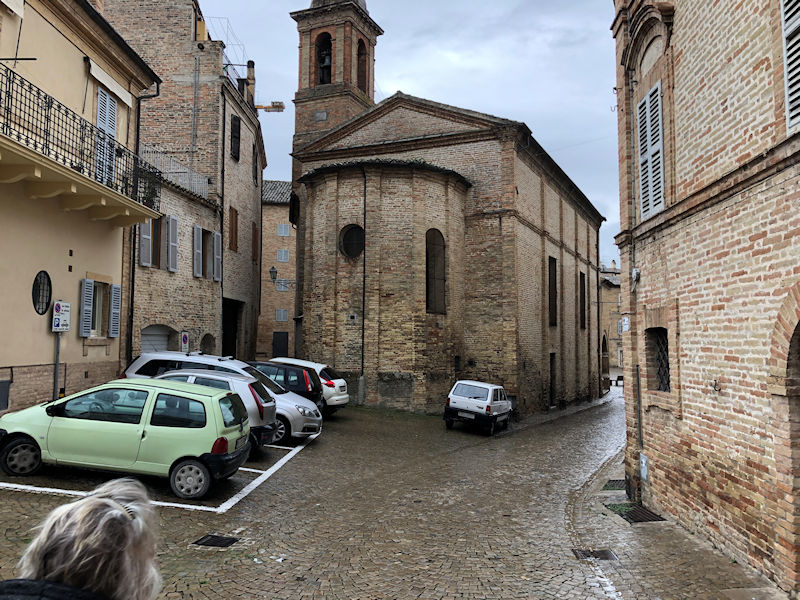
A break in the rain and we're going back up to the central piazza.

The colors of all the brickwork here are so different from that of the grey travertino marble traditionally used in Ascoli.
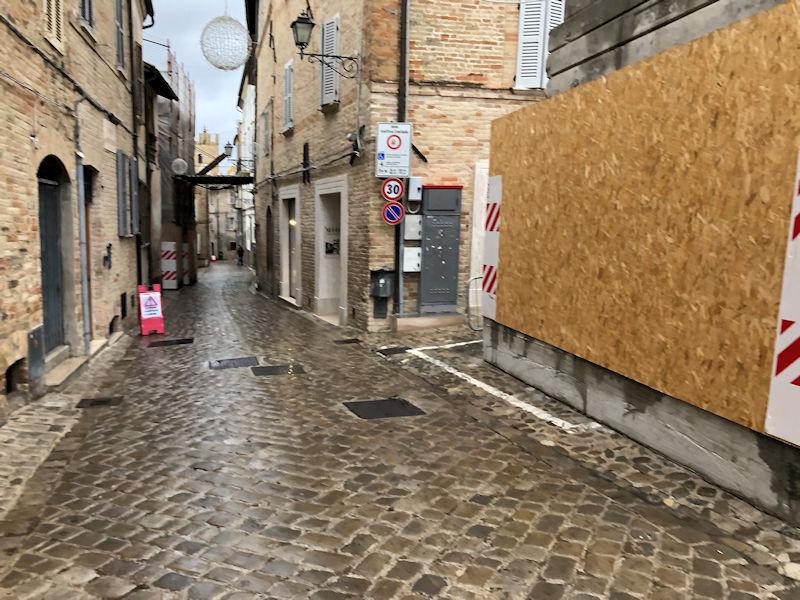
Descending the Via Serpente Aureo towards the northern gate

That's the Vecchio Ospedale, the Old Hospital, which in 1796 replaced an earlier hospital established in 1430, funded by the 'Disciples of the Broom', a lay charity that preached penitence and peace on earth. In the early 15th century it was commandeered for a residence for his son by Francesco Carrara, the lord of Padua, who'd conquered both Ascoli and Offida, but when the Carraras were expelled it was returned to the management of the Brothers of the Holy Trinity. It presently serves as an outpatient clinic and Urgence.
That's a war memorial in the piazza here at the end of the Via Giuseppe Garibaldi, and just a few steps away we find . . .

. . . the 'Bastion of Offida', near what presumably would have been the gateway to the city. There were fortifications here from the 12th-13th centuries, including a moat, but what's left of the present constructions date from fortress facilities that were constructed in the late 15th century and completed in 1494. It was ordered up by Pope Innocent VIII Cibo to discourage the chronic warfare between Ascoli and Offida, disturbing the peace of his Papal States. In 1493 artillery platforms were added to the three towers.
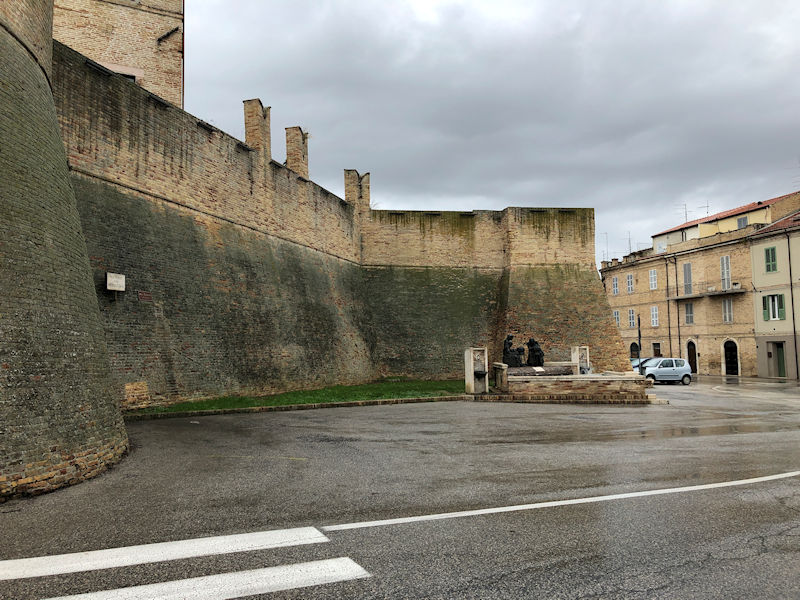
Just round the corner, outside the remaining city walls, the Via Serpente Aureo becomes . . .

. . . the Via Enrico Berlinguer, the leader of the Italian Communist Party who died in 1984. The square and round towers seen here are all that remain of the original circumvallations, and on the left side there . . .

. . . is the Fontana Monumento alle Merlettaie, a tribute to the traditional women lacemakers created in 1983.
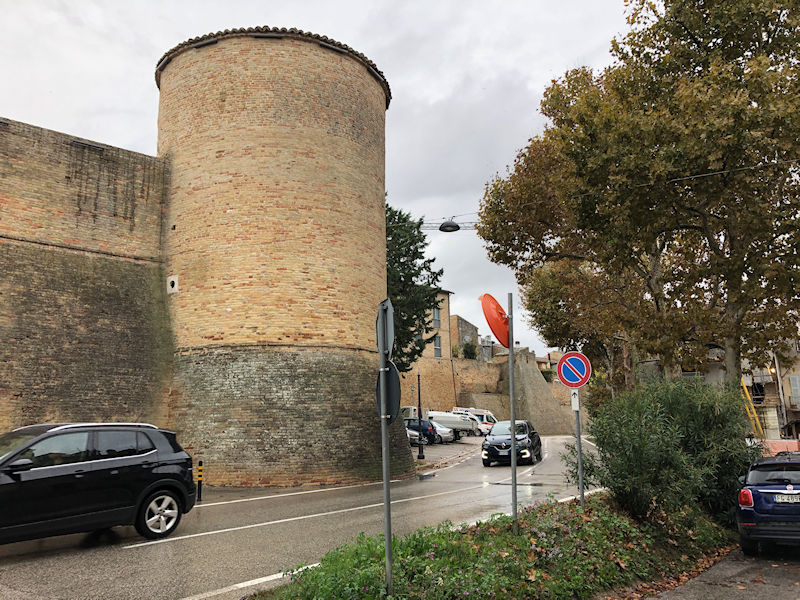
The third of the towers

Back past the war memorial (which is not terribly exceptional) to . . .
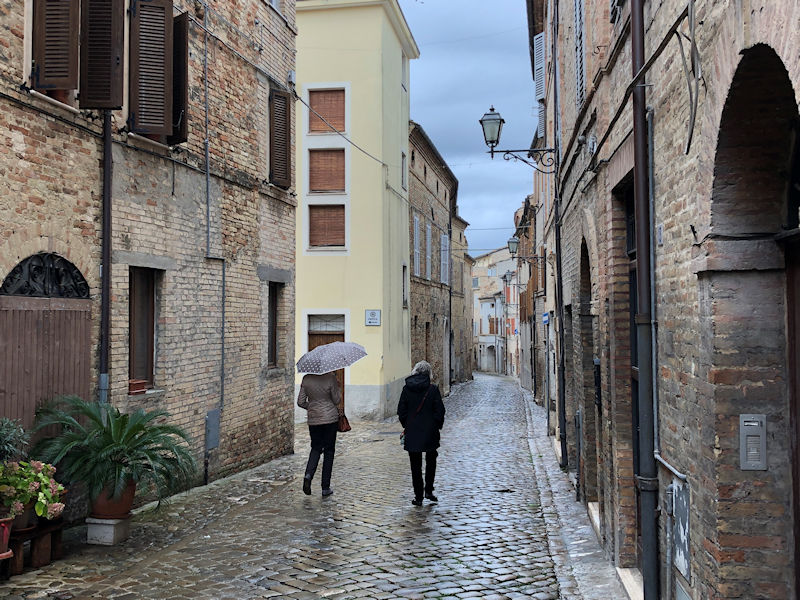
. . . rejoin our party. Brollies out!
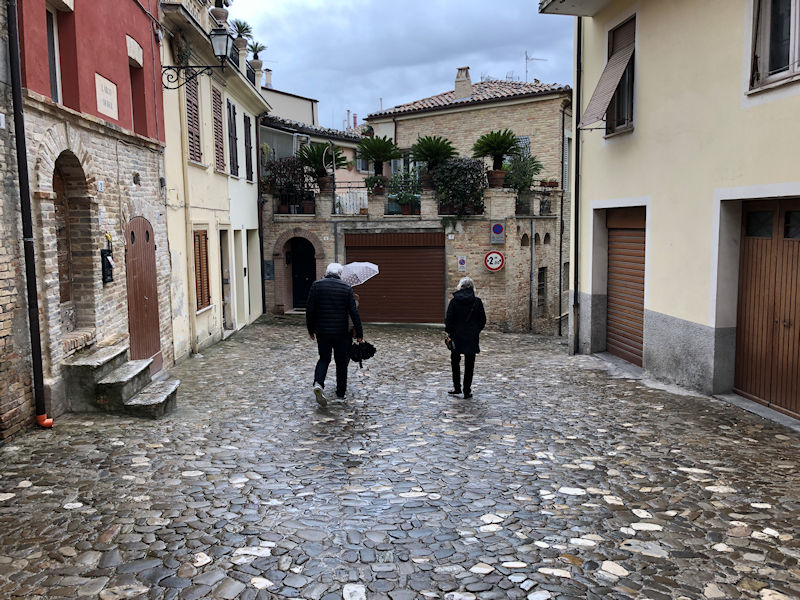
We're running out of the time we've allotted ourself for our first village of the day, but we'll cruise around a bit to admire the sights.
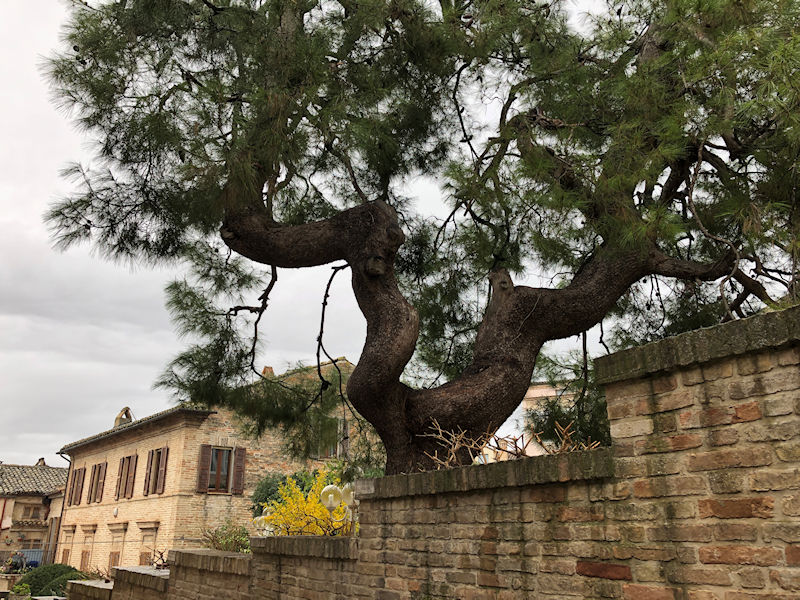
Like this one

And this one
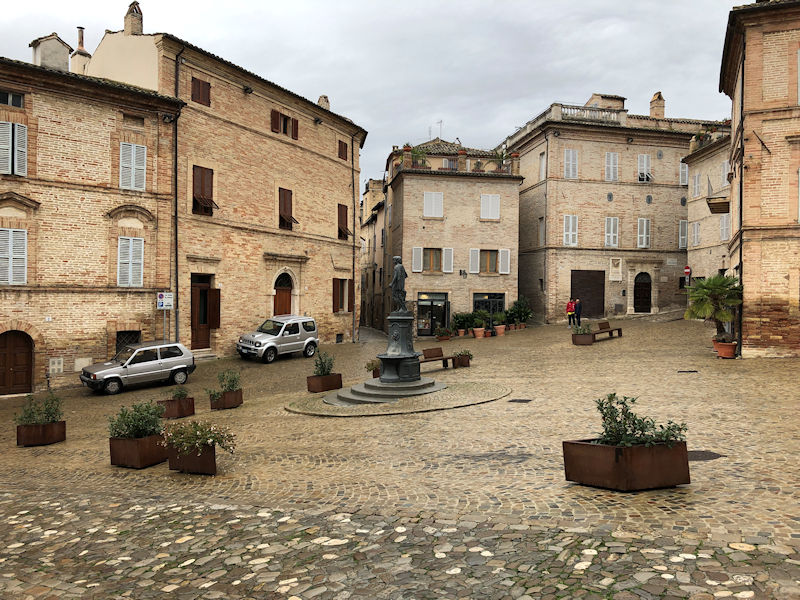
We've come round in a circle and here's the Piazza Valorani again, and . . .

. . . the back of the Addolorata.

This is the sort of weather in which arcades can really be appreciated.
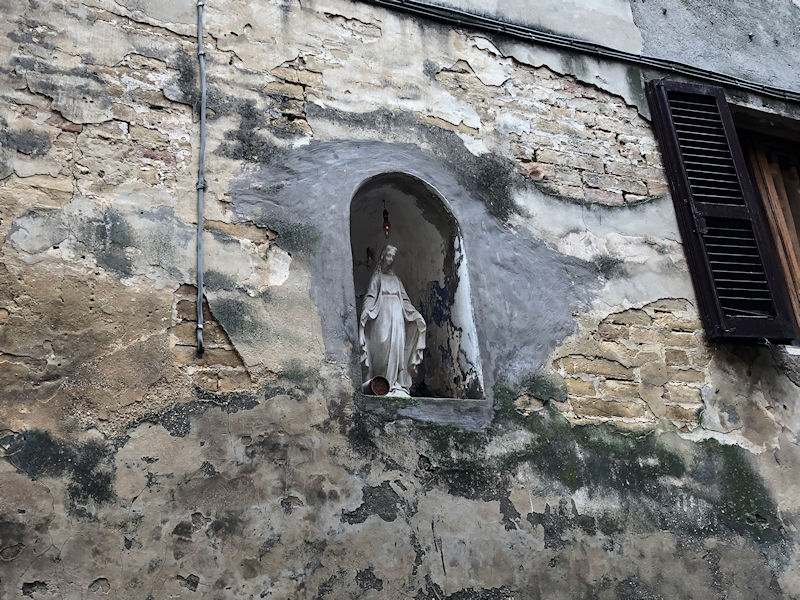
Every neighborhood needs its own dedicated spiritual protector.

We've had time to see a lot in Offida, but unfortunately we blanked on its most famous attraction, the Chiesa di Santa Maria della Rocca, stuck out on the end of the rocky ridge overlooking the countryside.
We only missed it by about 300 metres. Now we're off -- next stop, we hope: Acquaviva Picena.

Bye bye, Offida. Keep up the good work.
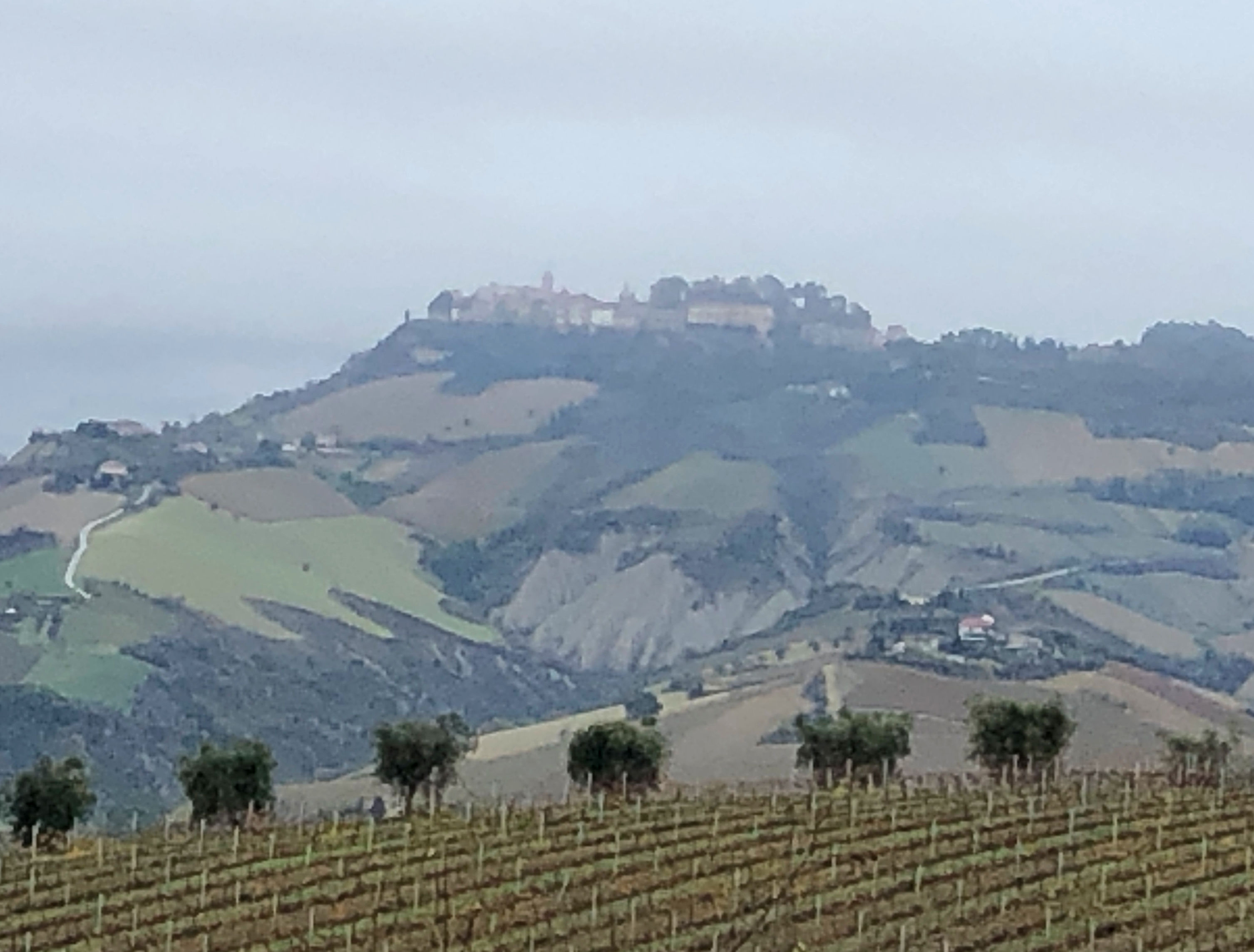
That, in the rainy distance, on a one-lane country road that the GPS gave as a prank, may or may not be the next hilltop village on our itinerary . . .
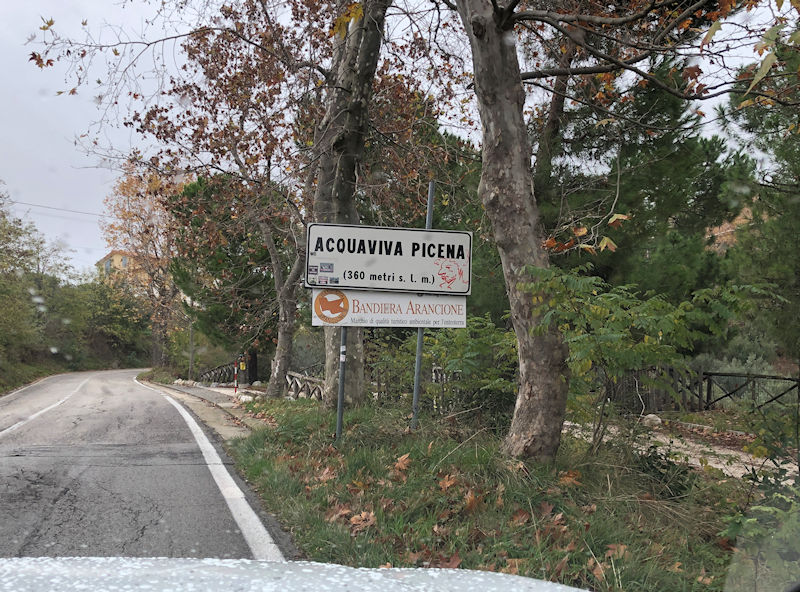
. . . Acquaviva Picena.

Entering town, with a glance at the surrounding countryside

A convenient carpark. Acquaviva Picena exemplifies one of the most noticeable features of these hilltop villages -- the entire town runs 2.7km long and about eight feet wide.

Our top priority here is the Fortezza Medievale di Acquaviva Picenza. If only we can find it.

Ah . . . right you are! Prayers can indeed sometimes be answered!
Actually, quite apart from prayers, we could hardly have missed it!

The area round Acquaviva was occupied by the Piceni and then the Romans, but with the coming of the Lombards and Saracens in later centuries the people moved from the coast up into the hills. The village here was owned by the Farfa Abbey from 947, but became a fief of the Acquaviva family, an important noble dynasty throughout the region, which built the fortress here in the late 13th century.

In 1341, we're told, the village and fortress came under the control of the city of Fermo and was garrisoned with the task of protecting the coastal villages, like San Benedetto, the present beach resort, from depredations by raiders from Ascoli Piceno.

The fortress and town were sacked in the late 15th century by Francesco Sforza's army, and the citizens set about rebuilding the fortress from 1486 to 1493, at which time it was enlarged and renovated by Giovan Azzolino with help from Baccio [Bartolomeo] Pontelli, a Florentine who worked on Duke Federico Montefeltro's Studiolo in Urbino and the façade of Rome's Santa Maria del Popolo, and designed the Sistine Chapel for Pope Sixtus IV delle Rovere in the Vatican.

This is considered to be one of the biggest and best preserved fortifications in the Marche region, and this corner building is the pentagonal castle keep, the most strongly fortified part and residence of the castellan and garrison. The serious sloping walls are mainly to prevent opposing engineers, usually called 'sappers', from sneaking close under a defensive cover and mining through the base of the wall.
The slopes outside the curtain walls are usually called a 'glacis', intended to strengthen against undermining, make escalades with ladders more difficult, and allow stuff dropped down ricochet off into the attacking force.

The area just outside the fort itself; fortifications surround the upper part of the town.

Through the arch into the piazza just outside the castle itself.

This is the Piazza del Forte, and there is a road just left of the photo sloping down, still within the fortifications, as part of the town, especially the Palazzo Chiappini housing the town hall.

The circular tower of the rocca itself, called the Mastio, is about 22 metres high -- the pentagonal castle keep is diagonally across the interior courtyard.


On the Google Map of the fortezza, in the middle of the Piazza del Forte it says 'Sagra delle Lumache nostrane e Spiedini', which translates as 'Festival of local snails and kebabs'. Go figure. So we did, and found this elsewhere: 'The Festival of snails and mutton skewers, in addition to the usual snail-based dishes, offers mutton skewers, stuffed olives, spelled, sausages, pancakes and this year's novelties, a tasty and delicious dish typical of the area, the "hunting rabbit". The event was held in the past from 10 to 17 August . . . If the event will be repeated again this year please notify us of the new dates' (Google Translate).
Unfortunately, we're probably going to be tied up next August, but we wish them luck with their tasty snails anyway.

Now we need to find our way into the fortress itself.
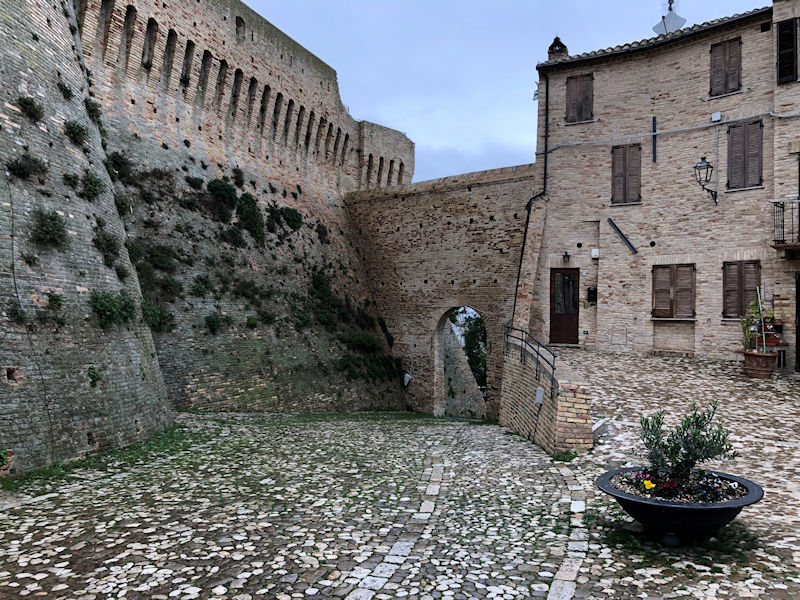
That's the way we came in, but there's another way out.
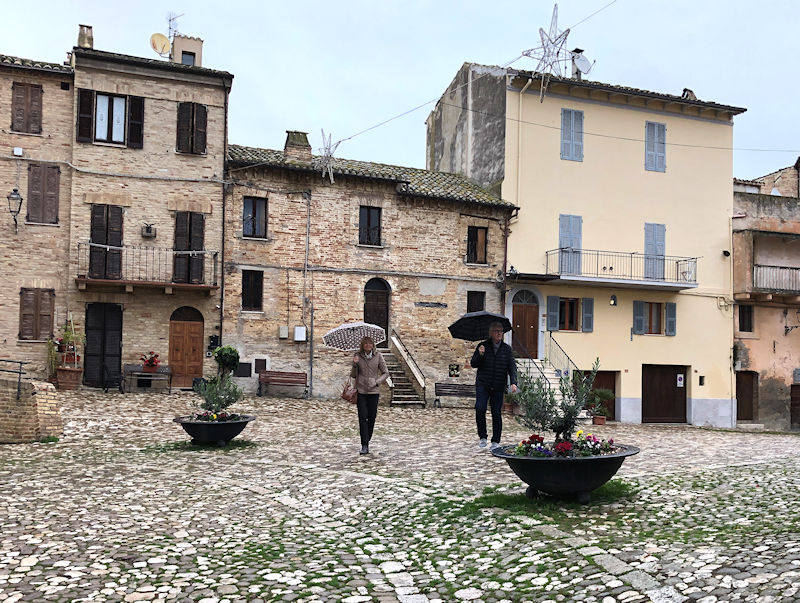
Cathy and Oscar rejoining our party

Just outside this gate from the Piazza del Forte, to the left here, is the present entrance into the fortress
itself . . .

. . . but it's closed. What a disappointment.

Now, raining again, back through the lower part of the town, and our way . . .
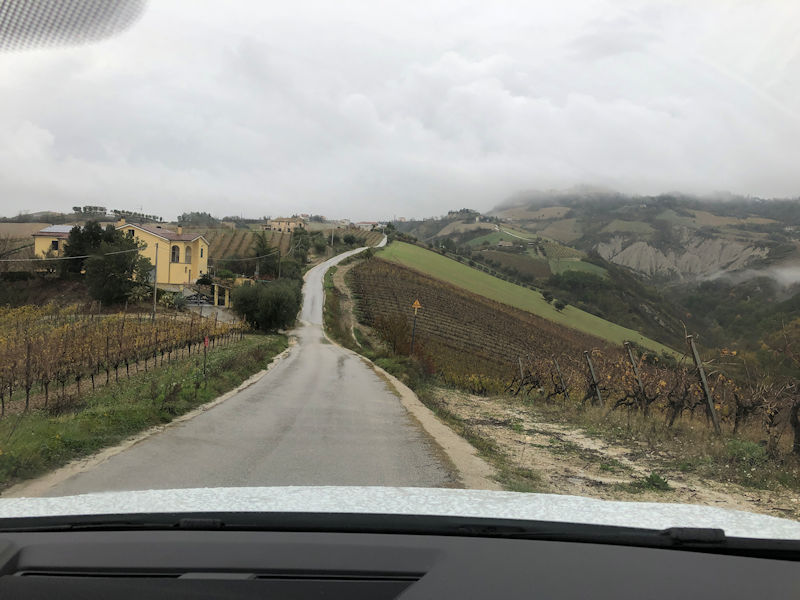
. . . on this lovely little rainy one-lane road towards . . .
 Dwight Peck's personal website
Dwight Peck's personal website




























































































